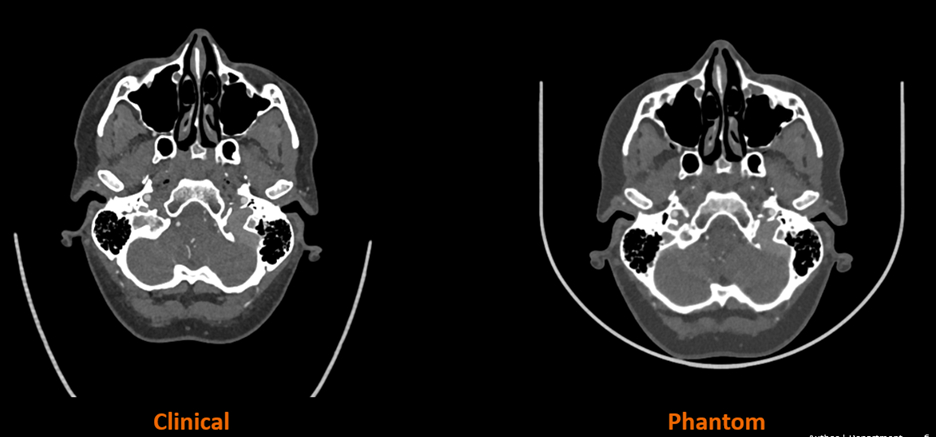3D printing stalwart Stratasys Ltd. (Nasdaq: SSYS) has partnered with Siemens Healthineers to advance medical imaging phantoms used in computed tomography (CT) imaging. The partnership aims to harness 3D printing to enhance the accuracy and efficiency of medical imaging.
CT phantoms are essential instruments in medical imaging, widely used in hospitals across the globe. These specialized devices are crucial for testing and confirming the effectiveness of CT scanners. Crafted to replicate specific aspects of human anatomy, phantoms play a key role in evaluating essential parameters such as the radiation dose and the clarity of images produced. This process is necessary for calibrating the scanners and maintaining their reliability and consistent performance.

Use of 3D printing may improve outcomes by providing 3D modeling to provider doctors with real scenarios to practice and consult with.
Stratasys and Siemens Healthineers will be using Stratasys’ PolyJet machines to 3D print CT phantoms from Stratasys unique radiopaque RadioMatrix material. Key to the endeavor is a sophisticated algorithm from Siemens Healthineers that translates scanned patient images into specific material characteristics with radiopacity that matches human anatomy. All of this combined will enable the creation tailored phantoms with ultra-realistic human anatomy characteristics and precise radiographic accuracy of patient-specific pathology, something not previously achievable.
This partnership is set to transform the usage of phantoms in the medical field. In some cases, it might even allow device manufacturers and academic facilities to replace human cadavers with 3D printed structures. This shift promises significant efficiencies and a reduction in human variability. The research will provide crucial data, fostering advancements in CT system algorithms, materials development, and unveiling new application areas and research opportunities.
“The current limitations of imaging phantoms have been a longstanding challenge for the radiology community,” said Erez Ben Zvi, Vice President Medical at Stratasys. “This partnership with Siemens Healthineers will enable us to jointly explore the vast possibilities of our radiopaque materials and 3D printing technologies to overcome these barriers.”
The project will begin with the production of 3D printed phantoms for smaller-scale anatomies, like the head and neck region, and will gradually scale up to include larger and more complex anatomies. The first phase aims to 3D print a heart model and an entire human torso with complete radiographic accuracy.
This novel development is only the latest in 3D printing for advanced medical applications being pursued by a nexus of companies. Ricoh, which is quickly making moves in the healthcare 3D printing sector, has an ongoing collaboration with Stratasys and Axial3D centered on increasing access to 3D printed anatomic medical models. The partnership combines Ricoh’s precision AM services, Axial3D’s Segmentation-as-a-Service solution, and Stratasys’ PolyJet 3D printing technology to streamline the process from medical scan to 3D printed model, making it faster and more accessible for healthcare providers.
Meanwhile, Ricoh also recently announced a partnership with Materialise, dedicated to making 3D printing more accessible and efficient in hospitals. By leveraging Ricoh 3D for Healthcare, a HIPAA-compliant and ISO 13485-certified medical manufacturing center, the collaboration intends to aid hospitals in establishing or expanding their on-site 3D printing facilities. Materialise’s expertise in 3D printing software solutions plays a crucial role in enhancing user experience and broadening access to vital medical tools like customized anatomic models.
Given the utility of patient-specific 3D printed implants, models, and devices, the medical field was one of the quickest to adopt additive manufacturing (AM). Now that that adoption is becoming more widespread, we’re seeing the development of niche areas for the technology. This is most demonstrated by Stratasys’s partnership with Siemens. Those outside of the medical space may never have considered the use of AM for calibrating CT machines, but now that it is happening, we’re sure to see a significant evolution in the radiography field that will lead to further niche applications.
Subscribe to Our Email Newsletter
Stay up-to-date on all the latest news from the 3D printing industry and receive information and offers from third party vendors.
Print Services
Upload your 3D Models and get them printed quickly and efficiently.
You May Also Like
Josh Makeshift and the New Gold Standard 3D Printing Content Creation
In the beginning, 2007 or so, 3D printing videos were almost wholly absent from the web. Then, here and there, makers started to upload pictures of their rickety RepRaps and...
Teen Developed Desktop 3D Printing Extruder
Inexpensive desktop 3D printing extrusion has always been an impactful potential ally to 3D Printing users. Filabot and 3Devo have been trying to make this a reality for years, with...
Polymaker Unveils HT-PLA & HT-PLA-GF Line of 3D Printing Filaments
Today, Polymaker has launched a new line of HT-PLA & HT-PLA-GF filaments. These enhanced PLA versions increase the glass transition temperature of PLA from a normal 60°C to above 130°C....
3D Printing News Briefs, May 17, 2025: Color-Changing Materials, Humanoid Robot, & More
We’re covering research innovations in today’s 3D Printing News Briefs! First, Penn Engineering developed 3D printed materials that change color under stress, and UC Berkeley researchers created an open source,...

































